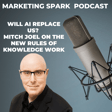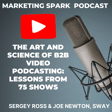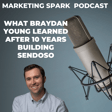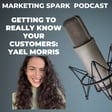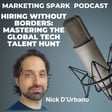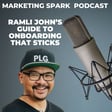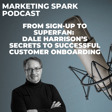Become a Creator today!Start creating today - Share your story with the world!
Start for free
00:00:00
00:00:01

Bridging Remote and In-Person Work: Insights from Drew Moffitt at KumoSpace
In this episode of Marketing Spark, Mark Evans talks with Drew Moffitt, head of marketing at KumoSpace, to explore the evolving landscape of remote and hybrid work.
As companies navigate the complexities of bringing employees back to the office while maintaining the flexibility of remote work, KumoSpace offers a unique solution. D
rew shares how KumoSpace is redefining virtual collaboration with immersive and interactive virtual spaces, helping businesses enhance productivity, engagement, and team culture.
Drew also delves into best practices for hiring, onboarding, and managing remote teams, providing practical advice for navigating the challenges of the modern workplace.
Transcript
The Evolution of Work Models
00:00:09
Speaker
If you asked someone a couple of years ago about the future of work, they would have probably told you that remote work was here to stay in a major way. In fact, you could have made an argument that where people work had become irrelevant or not important as long as the work got done. Today, however, the pendulum appears to be swinging back to in-office work, as more companies look to bring employees together for a variety of reasons.
00:00:37
Speaker
And what we've landed upon is a hybrid world in which a lot of people work remotely and in office. One of the challenges is not everyone is in the office at the same time. So there still needs to be a way to foster collaboration, teamwork, and culture.
Introduction to KumoSpace with Drew Moffat
00:00:52
Speaker
One of the companies trying to bridge the two worlds is KumoSpace, which is attempting to redefine remote collaboration by creating immersive interactive virtual spaces that bring together teams no matter where they are in the world.
00:01:06
Speaker
In today's episode of Marketing Spark, we'll dive into KumoSpace with its head of marketing, Drew Moffat, explore the unique features that set the platform apart, and discuss how businesses can leverage these virtual environments, enhance productivity, engagement, and team culture. Whether you're a startup founder, a remote team leader, or simply curious about the future of work, this conversation is packed with insights you won't want to miss. Drew, welcome to the podcast. Thank you for having me. I'm excited to chat today.
00:01:35
Speaker
Why don't we start by setting up the conversation with a description about Kumo space, how long you've been there, what the company does, how you think or how the service fits into the current ever evolving working landscape where we've got hybrid, we've got people working from home, we've got people trying to do both at the same time. Where does Kumo fit into the scheme of things and what kind of traction are you seeing
00:02:04
Speaker
as the workplace landscape continues to change. I lead marketing at KumoSpace. We're the number one virtual office, off-ware provider. So what that does is for specifically remote teams, it makes collaboration and problem solving and impromptu conversations as easy and as simple as going and just stopping by a colleague's desk or tapping them on the shoulder.
Market Trends and Work Models
00:02:30
Speaker
So what's the last year been like for Kumo? People are obviously going back to work. You've got some of the major US banks that are asking their employees to come back to the office five days a week. On the other hand, you've got many B2B SaaS companies who employees have just accepted the fact that work is all remote. Now, what are you seeing out there? What's your feel for how the work pace is evolving and how do you tap into
00:02:59
Speaker
different needs for different types of companies.
Marketing Challenges for KumoSpace
00:03:01
Speaker
We're a pretty early stage startup. We're a series, a company, a little history of the company. We just threw this product out there as better group video chat. Did wildly well during the pandemic, but what we realized was a lot of those customers were virtual events customers. And we were having fortune tens, fortune 500 startups, kind of everyone using the product all around the world. And then we saw this subset of customers that were a hundred percent remote companies that were trying to replicate those benefits that you do get from a physical office.
00:03:31
Speaker
The challenge is marketing that because if you talk to these banks or these executives that are pushing for return to office, you can often quite comically realize how they stumble on themselves trying to describe what those benefits are. Because it's not something as simple as, hey, it's CRM, which organizes all your customer information in one place. It's the culture that you might get. It's the speed at which you can communicate. It's the transparency and accountability to what's happening in that organization around you.
00:04:01
Speaker
And ultimately it's really the ability to be more collaborative and actually be more productive. So I think it's important to think for us in the landscape, we really think ourselves servicing the SMB space particularly well, right? Typically it's a service provider, less than 500 employees. We have larger customers. So we're a lot, very much removed from this debate of is it going to be in person? I was listening to Jamie Dimon in a Wall Street Journal article.
00:04:30
Speaker
interview this morning, and he was like five days in the office. And maybe that's the right thing for JP Morgan, but that's not the company, that's not a company that's going to buy KumoSpace, but there are thousands and thousands of companies out there that are committed to 100% remote. And remote work is very productive, but typically that productivity is contained to individual contributor work.
00:04:54
Speaker
as soon as you start going across that bound to cross-departmental collaboration, that's where Slack and Zoom really fail and KumaSpace stands out.
Technology's Role in Remote Work
00:05:03
Speaker
It's ironic that many of the benefits of in-office work advocated by people like Jamie Dimon, who has become the torchbearer for five days in the office, the culture, the collaboration, the ability to have impromptu conversations,
00:05:25
Speaker
Technology can address a lot of those challenges, a lot of those needs. It doesn't necessarily have to happen in person. So in some ways, all the things that a corporate leader is asking for or demanding, they think that it's only possible in person. Whereas the reality is technology can do a pretty good job of handling a lot of those, a lot of those challenges.
00:05:48
Speaker
Absolutely. And I think if I had to take a bet for the future, I think a lot of the companies, it's somewhat ironic, a lot of the companies that are actually calling for 100% back in office are often ones that have just missed their earnings estimate on Wall Street.
00:06:04
Speaker
So if it's like knee-jerk reaction, but what you're actually often going to have happen, and you saw this with the Spotify layoffs, right? They're like, oh my God, we laid off all these people and we're actually doing less work. Who thought? So I think in the future, a lot of the most productive companies are going to end up being largely remote. And a lot of the most profitable companies will likely be that way because they'll be able to engage in cost arbitrage, the cost
00:06:32
Speaker
physical office space it doesn't produce money if you can have technology replicate that exact benefit that's a an opportunity to grow your margins. Thank you for setting the stage thank you for that information about kumo i think a lot of people are grappling with.
Remote Hiring Best Practices
00:06:50
Speaker
the benefits of remote work, the productivity of remote work. So anybody who's interested in a virtual space should definitely check out Kumo. It was interesting. We were teaming up this podcast and trying to identify what are we going to talk about? What's the issue that can offer value to the marketing spark audience? And where we landed upon was the idea that if you guys are talking the talk and walking the walk and you as a marketing leader,
00:07:18
Speaker
have a remote marketing team. And I was really interested in, and I think a lot of marketing leaders are actually dealing with this new reality is how do we hire? How do we onboard? How do we train? And I got excited about the topic because I just, it's not a topic that a lot of marketers talk about. We were trying to do our thing, trying to make things happen, trying to execute wherever people are.
00:07:40
Speaker
But I thought that you could provide some really good insight into the different pillars of having a remote workforce. And I wanted to start off with of hiring. And the reality is when you hire someone new, you may never meet them in person. You may meet them on a Zoom call. You may get a feel for their personality and whether they're a cultural fit. You can provide some insight into that
00:08:07
Speaker
remote hiring process. What are some of the best practices? What are some of the things that you should avoid? What are the red flags that come up that you can discover virtually? How does that process compare to what you would do if you're doing in-person hiring? A lot of loaded questions there. There's a lot of fun stuff to dive into. So I'll start and just describe how we approach and particularly I approach hiring.
00:08:32
Speaker
Like a funny anecdote here is the company had never, not the entire team had never met one another until about two years into the company's life cycle. The company is getting close to four years old. I've been here, the second employee, the longest tenured employee now. I've been here for almost 10% of my life. And what we realized in that moment after the pandemic had worn down and we got everyone together for an offsite in Miami, Florida, is we all had quite strong personalities.
00:08:59
Speaker
not meaning like very outgoing or very like our personality was not muted in some way. And what we realized quickly is we had this selection bias that was probably coming from hiring people remotely related to the fact that if you have a more
00:09:16
Speaker
Whether that's an introvert or an extrovert, you're nerdy, you're a business person, your personality probably gets somewhat muted by the video calling behavior. So that was a fun anecdote that we learned. But for us, we sit down and say, okay, let's run a really fair process, right? Document what our process looks like at the start. So it's very clear there's going to be four steps. There's going to be five steps. There's going to be three steps.
00:09:43
Speaker
And then we go through that process. I make sure one of the things that I see people mess up so badly is at the end of that first interview, and I've been involved in six hires in just this year alone, is not asking what I call the housekeeping questions, where you're like, okay, what's your notice period? What are logistics around getting paid, visa, anything like that kind of situation.
00:10:08
Speaker
Ensuring the person's aligned on comp. Just because they applied, just because maybe you published the comp doesn't mean they're actually aligned on it. And then explain every step of the process and let them ask questions. So I think a good hire literally starts with you as the hiring manager having your JD. That exercise, you may have to rewrite it because it may change or your expectations or desires may change, but have a process like, all right, we're going to run this. We're really good at being frugal here.
00:10:39
Speaker
We don't have a fancy ATS. I write a JD in a Google doc, post it to well-found. I write a process doc, and we use a Google spreadsheet to keep track of it. But we can run a very efficient process that way.
00:10:53
Speaker
One of the realities of offering jobs online, and you see this all the time on LinkedIn, is when somebody posts a job, there are 50, 100, 200 applicants, especially in the marketing space where there has been drastic cutbacks over the last year, and you've got some really talented people looking for work these days.
00:11:15
Speaker
What are the challenges of sifting through all those applications and what are some of the key characteristics or skills that you're looking for to hire people who can be successful remote workers? For better or worse, I've gotten good at this because I've had to do it so much lately. I think the first thing that you need to do as the hiring manager is really write your JD and be prepared to assume that your JD was written poorly because
00:11:45
Speaker
Like I tried to compare what I wrote in the JD to what's on that person's resume. So recently we were hiring a senior editor and copywriter, and this was a really arduous task for us. It took us 250 applicants. We rewrote the JD three times. Part of that failure was on our side. It was.
00:12:07
Speaker
Us as a team not being fully aligned on what we actually want out that person did we want someone who is more creative who would be really good at Helping us move the brand content voice and style guide forward or did we want someone who was just gonna edit this AI written content that we leverage and just do that at the machine level and So when I'm looking at those applicants, I was saying, okay, what is their career?
00:12:31
Speaker
Okay. They've been at a startup they've been for three years. They've been writing for this type of content. It's B2B. Those would be good flags. But unfortunately there is a ton of really great talent out there that's applying, but there's also no barrier often to applying. So that's where you end up going through over 250 applicant applications and there's no substitute to hard work there.
00:12:56
Speaker
Once you've narrowed it down, what is that process? Do you jump on a Zoom call? How do you whittle down? How do you go from 250 to 50 to 10 to five? There's so much work. Are you using technology? Is it a manual process?
Effective Onboarding of Remote Workers
00:13:14
Speaker
Do you interview 50 people on Zoom? Walk me through that process because I think one of the challenges facing a lot of marketing leaders these days is that
00:13:23
Speaker
It's like going to a buffet. You get there and there's so many options and they all look so good. Everybody comes with great credentials, but you've got to find someone with the right skills, with the right attitude that can fit into your corporate culture, that can be part of your team. There's so many variables that go into a good hire. Like how do you eventually boil down the ocean where you can focus on, okay, these are the five candidates I want for this one job.
00:13:48
Speaker
It's got to be, at this point, it has to be labor intensive or maybe you've got some technology that you're using or some process that you're using to make it easier. For us, it's definitely not tech. It's a strong process. So first thing is we're using KumoSpace. So the team's showing up and working out a singular virtual HQ. That's where we do all of our interviews. So from a reaction to that.
00:14:11
Speaker
This person's coming, this is also where we do all of our sales demos. You go to the website, you click book a demo, you'll show up right there. I'll probably be hanging out in that office and I may say hi to you. So that person is brought in just like you would in a physical office. So you're already starting to have those subtle kind of cues of, oh, does this person react well to this idea? Or is this person wowed by it? Or are they feeling like, oh, maybe this isn't the company for them? So you're already sussing out where there may not be a good fit.
00:14:40
Speaker
And then the second step, the first step of that is I do that, what I call a phone screen. And at the end of that, I make sure we're rock solid aligned on what the comp is, what the timeline, what the interview process looks like really want to be fair to them. I'm not a religious person, but I'm like.
00:14:58
Speaker
Put it into the universe if I was on the other side of this table I would want someone to be that transparent with me And then what we often do is ask people to do an exercise for us and yes It's a little more labor intensive But we go ahead and we pay them a couple hundred bucks to do that exercise
00:15:13
Speaker
Why? It's not a lot of money to them. It's not a lot of money to us. If anything, it's probably more work for our accountant. She definitely doesn't love that we do this, but it's a sign of who we are as a company, right? We are val, we are signaling to them that we value their time. And I've had people really positively respond to that. And at the end of the process, if they've actually gone through the exercise, I'll hop on a call.
00:15:35
Speaker
And I'll let them ask me some questions about how we came to that decision. So again, they can feel like they're engaged in a very fair process. So those are the kind of like below the surface ways that we're sussing out. Is this going to be a good cultural fit? Are these people going to feel confident in getting hired by Kumo Space? Or are they having reservations? And we're very transparent. So it hopefully encourages them to be transparent with us and ask a lot of questions and feel comfortable in it.
00:16:02
Speaker
And for this particular role, we already had defined a con, a content editing process. So we're like, Hey, next round is you're going to meet with Rad who's leading the content SEO effort. And you're going to take about 30 minutes meeting with her, like a normal interview. And then you're going to spend about two, three hours in your work out of Kuma's virtual HQ here. And.
00:16:24
Speaker
You're going to edit one of these AI written articles for us. And as you have questions, find Drew or find Rad or Kyla and ask them. And you're getting to almost work. It's a bit akin to how banks do those like super days. But we're doing this virtually. We're doing this with people who I can't say in Europe, I'm in New York.
00:16:45
Speaker
Rads in California, head can in South America, Canada. So yeah, I would say you definitely show up at the buffet and I'm more inclined to take that first phone screen. Yes, it consumes my time, but.
00:16:59
Speaker
Unexpectedly positive things can happen. You whittle some of those down and say, okay, I just don't think this person is the right fit. Maybe it's the type of content they'd be rating. Maybe it's like the concerns about their ability to write in English, things of that nature, cultural fit, things of that nature. Move to that second phase. Now you've actually got like a work product. And then the last phase of that process was meeting with one of our co-factors. So that was a pretty quick.
00:17:24
Speaker
That was only a three-step process. Some of our processes are a little longer, more like five steps. But that's how we went from 250 candidates whittled it down. We found, as we got to the end, we said, you know what? We actually want a different looking candidate. It's unfortunate. So we're going to go rewrite this JD and do this again. You've bow down the ocean. You've found that candidate. You've hired them. That's one step. Obviously, a lot of work involved there.
00:17:50
Speaker
what are best practices for onboarding remote employees to ensure they feel connected to the team and the corporate culture, the sense that
00:18:00
Speaker
They've made it through the gauntlet. They've, they're the ones who have been selected. They just sense that they're, that they're part of a team that they're valued, but that they're not being left to their own devices. Cause obviously in the real world, you come to the office, somebody shows you around, you meet your colleagues, they take you out for lunch. It's they, there's training wheels that are applied to a new hire in the rural world. But how does that work in the remote world where
00:18:30
Speaker
somebody's got to perform. That's why they were hired, but they also need to feel valued and they need to feel like there's camaraderie right out of the gate. So what do you do in the short term? And then what are some of the common onboarding mistakes that a company should avoid?
00:18:44
Speaker
The way that we've gotten better at doing this, we definitely were not, we didn't come out of the gate perfect at this. I'm sure the process can get better. It's been getting better. The first thing is I give these candidates or these new hires a, an onboarding plan and it's typically a one, two page document. It's got information in there, like just general information about the business, about Kuma space, the company. It could be recent like marketing meeting presentation slides, for example.
00:19:11
Speaker
Just trying to get them up to seed. It'll have specific process docs that we've gotten really good in the last year or so, starting to break down things that we do into just documented one, two page process docs. And that's specifically going to be related to their work. And then there's also just, here's what you can expect week one, two, first 30 days, 60, 90 days. So pretty standard stuff on the back end of that.
00:19:36
Speaker
set up some one-on-one meetings that are also going to happen that are just some of those can be like, hey, here's the other people on the marketing team, meet them, interact with them, just talk shop, what hobbies you like to do. Other of those meetings are like, hey, this is going to be super relevant to the work you're doing. So this person is going to walk you through something that they just completed.
00:19:58
Speaker
And then try to touch base with them kind of daily. The, I obviously touting Kuma space, but going back to that, like they're showing up and working in this virtual space. So there's that transparency, that visibility to what's happening. I make myself super available during the course of the day. And I encourage them, come find me as soon as you have a blocker, as soon as you have a problem or a question or something.
00:20:22
Speaker
And then I also encourage them to do the same with other team members on the marketing, on the sales team, on the customer success team, on the engineering team, et cetera. So they're really mingling and starting to know where they can go to get help versus just feeling, Oh my gosh, who's the right person to Slack? Or I don't really want to book a formal zoom call with this person. I met them once for three seconds on a call or something.
00:20:48
Speaker
What are some of the mistakes that companies should avoid? Obviously, there's the idea that out of sight, out of mind. If you hire a remote person and they're hired to do a job and they start doing the job and you can onboard them, you can give them the package and the compensation and when they get paid. But what are some of the mistakes that companies make when they've hired someone, you've onboarded them.
00:21:12
Speaker
They dropped the ball for some reason. What are some of the things that you've seen from your experience, some of the things that you've learned from onboarding multiple employees? The first one that jumps out, that's probably the most jarring to me is being the longest tenured employee at the company. I just have so much informational knowledge. And a new team member, whether they're joining the marketing team or they're joining another member of the team and they have an idea, it's, Oh,
00:21:40
Speaker
They have that idea, but maybe we tried that idea, but they weren't here when we tried that idea, for example. So I think that's a really big problem that people forget is that they're just like, Oh, there's so much that these, that this person that's coming and joining the team doesn't know about the company. So.
00:22:01
Speaker
being like embracing that. That's what's caused me to start sending all this information that might be four or five documents on the day they start and just say, Hey, take the day and read through this information. So you are getting a little bit of information, but that can be a, that could be an in-person situation as well. A new employee comes and got lots of ideas. They have no track record with the company. So there may be a bunch of stuff that's been tried that they think is
00:22:30
Speaker
obvious. You guys have been there done there. When you talk about when you talk about onboarding mistakes, remote onboarding mistakes, obviously, institution knowledge is one of them. Any other things that you would highlight?
Integration Challenges for Remote Hires
00:22:41
Speaker
It gets exacerbated in a remote environment, right? Because if your business is being run by teams or Slack and Zoom, that person is truly isolated. They effectively have a messaging tool and a phone calling tool, but they have no other situational context. At least in a physical office, there's maybe things happening that help bring them up to speed on that information. So they're just even more isolated. But yeah, you're absolutely right about that.
00:23:11
Speaker
I think.
00:23:12
Speaker
The, I haven't done it because this is the only company I've worked at remotely and we've always used KumaSpace, but recently hired a colleague and she came from Amazon and she was on board at Amazon when they were still a hundred percent remote. And she spoke about how she was just left. Like they hired her to do account management and she was like managing accounts and then she wasn't hearing from anyone. So I think that is probably the biggest thing is that you're not
00:23:42
Speaker
Like these people might be very smart. They might be very skilled. They may have a great resume, but they need to be touched. You need to check in with them daily, a couple of times a day, or even they need to be able to talk to other team members. Otherwise they're really going to be siloed. So that's a big piece of it that I would say companies really mess up from a remote perspective. The other piece is just equity.
00:24:05
Speaker
I'm not talking about stock options. I'm talking about the sense that they have employee equity. They have equal opportunity. They have equal visibility, especially in the hybrid world or a world where some of the people are going hybrid and some are 100% remote. When I use the words transparency and availability and accountability,
00:24:28
Speaker
I can see our co-founders working. I can see, and the new hire can see them in our virtual office in the same way they would in a physical office. When you're a remote hire, you may never get any visibility with someone who isn't directly below or above you for the first couple months of your time at the company.
Assessing Productivity in Different Work Settings
00:24:49
Speaker
That's interesting from my work experience. Obviously I grew up professionally in the office and a lot of the
00:24:58
Speaker
things that I did was around relationship building, going for coffee or drinks with my boss, hanging out with my coworkers, essentially trying to, the reality is when you work for a company, you're competing with, you're working with other people, but you're also competing with them. You're trying to get a promotion, you're trying to get a raise. And so there's other things that you need to do to drive relationships and connections. And that's hard in the virtual world because
00:25:24
Speaker
You just don't make that happen, or it's harder to make that happen. Maybe Kumo Space can solve that issue. But you also mentioned Miami and the fact that everyone got together, they had never met each other and you got together. What are your thoughts about
00:25:40
Speaker
physical interactions, getting people together for dinners or retreats or getaways or trips. And the idea that yes, you can get to know each other virtually. You can do zoom calls. You can hang out in a virtual office. You can go back and forth on Slack, but.
00:25:58
Speaker
doesn't 100% replicate that real world experience. So what are your thoughts about bringing people together? How often should you do it? How should you do it? How do you make it work? How do you make it not be awkward for people who may not be so outgoing or best practices for making that happen, having that part of your remote work reality?
00:26:20
Speaker
KumaSpace is great at helping to build some bonds, but at the core, what we've learned about company culture building is that it's not a virtual happy hour once a quarter, once a month. It's not those forcing interactions. It's two things. One.
00:26:37
Speaker
There is, it's the spontaneuity, right? Having those burst moments that happens just because of the way the tool works and the way that you communicate from sync to async. You have these brief moments. Hey, how's your day going? Oh, that's interesting. Very quick first interactions. And that builds bonds because you get to know people, but the flip side is there is no replacement for just getting together physically and having some food together or drinks or something or playing a game or something.
00:27:07
Speaker
So we, even though we're a hundred percent remote company, it may be more apt to say that we're mostly remote first. We do two company off-sites a year where in a few days I'll be flying to Orlando this time in Florida and we're going to be there. We're going to work together. We're going to have some days we're doing some fun stuff. There's some days where we're actually just doing meetings, some days that we're doing strategy, but we're going to be working together for a full week.
00:27:32
Speaker
And then also I happen to be in New York. The two co-founders are in New York. Some of the team is in this area as well. And whenever anyone is in the vicinity, we also try to get those people together. So if a team member, you know, I was speaking about this team member that we recently, that was formerly at Amazon.
00:27:52
Speaker
She was coming to visit a friend in New York. So we made an effort to get together and have dinner as a group. It's good to have those moments because yes, you're not. We're a 20 person startup. Competing for promotions is a little different than in a 200 or 2000 person organization. But in order to make everyone row at the same speed and succeed and beat the odds of a failure that is in startups, you need to have strong bonds with the coworkers.
00:28:20
Speaker
regardless of if they work together or they're in different departments. So yes, you need to invest in culture. I think it's unfortunate realities. A lot of companies don't. We know for a fact from our data that companies talk about culture, but they really buy our product for collaboration, communication, and productivity. It's unfortunate. I think companies should really think about spending more money on culture. The other I want to talk to you about
00:28:45
Speaker
is around quantifying success and performance in the real world. A lot of it is relationships
00:28:53
Speaker
if you're friends with your boss, you're friendly with your boss, then there's an affinity. People like, they like working with people that they like and trust. And so in the real world, you can build that kind of rapport, that kind of, that those relationships, and that can be part of the way that you're assessed in terms of your work. It's people are biased, everybody's biased. And that's reality. What about the remote work world where many people say that
00:29:23
Speaker
It doesn't matter how you work, it's how well you work and what you do. So for example, people will say, you shouldn't be able to, you should be able to do your laundry and take your dog for a walk and pick your kids if you work from home as long as you're doing the job. That's one way of being assessed in terms of how well you're doing. And there's other people that are saying like, listen, you gotta be in the seat nine hours a day, you can take a lunch break.
00:29:51
Speaker
I guess there's different ways to skin a cat. There's different ways to tell whether someone's working or not. How do you approach that in terms of assessing the success of your people and when you're not physically seeing them every day and you don't have that relationship every day? There's a couple pieces here.
00:30:07
Speaker
The first one is sometimes people's reaction in Kubernetes space because there's a visual visibility aspect to it, right? You can see these people in the space. You can see their status. They're like, Oh, is this a surveillance tool? And then it's absolutely not our intention to build it as such. And we discourage anyone who's trying to buy it as such.
00:30:24
Speaker
And, but at the same time, it's about giving you the transparency as a team member to know what's happening around you so that your colleague is out getting lunch. That colleague isn't probably the person I should go be waiting for a message back from. Let me find a different colleague who can unblock my problem.
00:30:44
Speaker
That's what happens a lot in Slack, for example, is you send the message, but you have no situational context to what that person is doing. And I think that's where people get frustrated. Oh, my colleagues away for a few minutes and they must be doing laundry, but like you had no understanding of what they were doing.
00:31:00
Speaker
or that they weren't in the office, in a physical office, you have that same thing. They went to meet a friend for coffee or for lunch, right? They're not at their desk. It's not, you don't have, in a physical office, no one's really getting chained to a desk. So in a remote world, you shouldn't be doing that as well. So I think you have to judge it from that perspective of, okay, my ability to like interact with these team members, what is my availability for them to interact? Because it's a two-way street here. They want, if you're a more junior employee, you want
00:31:30
Speaker
the sense of knowing what's happening in the company. You want to see the two co-founders talking and having a conversation maybe with the door open. Okay, I need to go talk to them. Let me go join that conversation. You can easily do that in the consumer space. Whereas if that door is closed, you're like, oh, that's a private conversation. In the same way, you would see that in a physical office.
00:31:50
Speaker
And you put there, I always make myself as a manager available to the team. And the other managers do the same thing to say, hey, come find me as soon as you have a problem. If I'm not there, send me a message and I'll get back to you. But you also need to respect that people are going to do their best work if they can have a happy life. If we're all slaves to our job, we're not going to create great work product. And that goes back to these
00:32:14
Speaker
very kind of draconian approaches that I think some executives are taking to saying, remote work is dead. We missed our earnings call. So we're dragging everyone back to the office. It's great. You just pissed off everyone. So they really probably don't care about next quarter's earnings call.
00:32:30
Speaker
You need them. The dog is an important part of their life. They need to be able to go outside and do that dog. There's a team member whose aunt is visiting from Pakistan. And she says, hey, I'm going to be working from 8 a.m. to 2 p.m. And then I'll be back online from 7, 8 p.m. for the last few hours of the day.
00:32:53
Speaker
I'm like, absolutely. And I know having worked with her for over two years that, yeah, she's working a shortened day. She's going to have a nice dinner with her family member, and then she's going to be back online. And I can look on the blog and see we've published a number of blogs for today.
00:33:10
Speaker
So how does it work in terms of assessing performance when you're not physically together and those relationship biases may not be as strong as you have when you're in person? Is it just how many blogs you've written in a certain month or are there other ways that you quantify remote performance? In the course of a day,
00:33:30
Speaker
I am probably communicating many tens of times with various team members in the same way that I would in a physical office because people are walking up to me and saying, Drew, what is this? Why is that? Can you help me with this problem? Something of that nature.
00:33:46
Speaker
So I'm getting a lot of those similar data points that I would. It's not like in a traditional use of Slack or Zoom, you wouldn't be having that many huddles or formal Zoom calls with someone during the course of the day. So I'm having those type of inputs. And at the same time, I'm also just having the actual outputs of their work, right? Here is our goal for blog posts. How are we trending?
00:34:14
Speaker
Are we behind or are we ahead? And that we're early stage startups. So we set a lot of ambitious goals. When we're beating things in the case of the blogs right now, we are, I'm like, that's a very, a positive outcome on someone's ability to perform.
00:34:28
Speaker
Regardless of whether they, where they perform. One aside that I didn't want to ask you is, okay, so in the Kumo space world, if I want to take 15 minutes and do the laundry, how does that work? Is there a laundry room that I go to in Kumo space or is there a designated out of the office thing? How do you provide that flexibility for doing laundry? You want to walk the dog?
00:34:47
Speaker
In KumaSpace, it's pretty much a top-down view of what looks like an office.
Flexibility and Future of Remote Work
00:34:54
Speaker
There's common areas like conference rooms and open spaces, and there's audio ranges within those, and then there's private offices that everyone has assigned, and they can have a private conversation with the door closed in.
00:35:05
Speaker
So there's statuses that you can use. So when I go and grab lunch, I put my statuses away and type in grabbing lunch. And then I come back and typically eat at my desk. If I'm running an errand or I have to like go do some kind of chore, I put that status in there. And then the person can, they have that situational context. And if they know, if no one else on the team can answer their block or their question that moment.
00:35:30
Speaker
Then they know they can just revert to the chat functionality that full threads and channels and things like that inside of KumaSpace on the mobile app. I'll get the notification as I'm walking to the post office to.
00:35:42
Speaker
deal with a package or something. And Amazon return. We're looking at the work landscape for 2024. I've seen a lot of change as people have recognized that it's time to move forward. It's time to adopt a different approach to work, or some companies in many cases are rooting back to their traditional approaches to work.
00:36:06
Speaker
From your perspective, what are some of the interesting or exciting trends or innovations in remote work that you see as the most, the things that people should be looking at, should be exploring, should be potentially embracing?
00:36:20
Speaker
You brought this point up earlier, which is like technology should be able to make remote work as collaborative, as productive as physical work. So like that trend right there is what's most exciting to me. I think right now what we, you were asking me like how we judge productivity. Sometimes I'll sit down with a team member and I'll say,
00:36:45
Speaker
Let's spell out the tasks that you're doing. What are the steps of it? So we're going back to the blog creation, for example, and we're able to understand that we can use AI. We can use labor in the Philippines for highly repetitive tasks that AI can't yet do today. And then.
00:37:04
Speaker
human editing for the copy and someone overseeing that and we've run that system quite well. We're going to create 60 pieces of blog content that rank quite well into Google search results.
00:37:20
Speaker
If we were not a remote company, we would not be able to do that, right? AI is a piece of productivity, but having different levels of team members in different cost markets is a entirely different productivity and ultimately profitability unlock. So I think that's going to happen for a lot of kind of white collar work. There's going to be some violent shifts to that.
00:37:47
Speaker
as people are experiencing it, but I think that's an exciting trend for me is.
00:37:52
Speaker
ability to access talent that is best suited to do a specific task in a broader thing that you are creating. This has been a great conversation. Lots of insight into virtual work in person work and where that's going to lead us in 2024. I think if I was an HR manager, I'd either be totally excited or terrified at the same time. Drew, where can people learn more about you and Kumo space? So.
00:38:19
Speaker
KumaSpace.com, you go to the website, you book a demo, you can hop right in there. If you guys want to use the paid version, you can just put in Marketing Spark as a promo code to get 10% off the first year. And as I said, when you do the demo, you'll see the whole team in there.
Contact Information for KumoSpace Inquiries
00:38:37
Speaker
And if you're doing this during kind of US business hours, East Coast business hours, I'll be in that space.
00:38:42
Speaker
If you want to interact with me on social media, I'm pretty active on LinkedIn, a little bit on Twitter or now X. And you can just email me also. My email is just drew at kumospace.com. Thanks, Drew. And thanks for everyone listening to another episode of Marketing Spark. If you enjoyed the conversation, rate it. Subscribe via Apple Podcasts, Spotify, or your favorite podcast app. And of course, share it via social media.
00:39:08
Speaker
If you're a B2B SaaS company and you're looking for strategic and tactical support to scale your marketing, we should talk about how it can help you as a fractional CMO and strategic advisor. You can reach out to me via email, mark at markevans.ca. Connect with me on LinkedIn or visit marketingspark.com. I'll talk to you soon.




